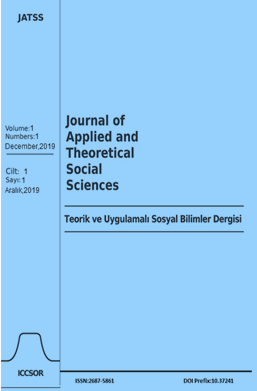Making Of The Modern Sweden
Abstract
Sweden is today’s one of the wealthiest countries in the world. The reasons behind this success could only be understood with a historical perspective. While looking to the history of Sweden, I realized three distinctive events which shaped Swedish culture, society, politics and economy significantly. Beginning with the early modern period in the 16th century and ending with the modern period in the second half of the 19th century, these three events are (in the chronological order) Swedish Reformation and the reign of Gustav I in 16th century, the rise of the Swedish Empire in 17th century and the industrial development in Sweden during the second half of the 19th century.
In this article, the effects of these three events would be analyzed in terms of their influence on the Swedish culture, state bureaucracy, politics, society, religion, economy and military with their backgrounds. The study on the backgrounds of these event show that these influenced each other strongly. Not only this, but also the influence of them shaped Sweden as it is today. Given today’s high life standards, the making of modern Sweden is a success story and understanding it with a historical analysis could be helpful for policy makers all around the world.
Metrics
References
Arrison, John G. (1994), ‘‘Time Capsule from the 17th Century: Stockholm’s Vasa Museum.’’ Technology and Culture 35, 1, 158 – 167. DOI: https://doi.org/10.2307/3106752
Beck, Andrew (1940), ‘‘The Rise and Fall of Catholic Sweden.’’ An Irish Quarterly Review 29, 115, 382 – 394.
Bergh, Andreas (2011), ‘‘The Rise, Fall and Revival of the Swedish Welfare State: What are the Policy Lessons from Sweden?,’’ IFN Working Paper, 873, 1-29. DOI: https://doi.org/10.2139/ssrn.1884528
Bowman, Franscis J. (1942), ‘‘Sweden’s Wars, 1611-32.’’ The Journal of Modern History 14, 3, 357 – 369. DOI: https://doi.org/10.1086/236637
Edvinsson, Sören, Hans Nilsson (1999), ‘‘Swedish Towns during Industrialization.’’ Annales de demograhie historique, 2, 63-96. DOI: https://doi.org/10.3406/adh.2000.2168
Erixon, Lennart (1997), ‘‘The Swedish Growth Engine.’’ In The Golden Age of the Swedish Model - The Coherence between Capital Accumulation and Economic Policy in Sweden in the Early Postwar Period, Oslo: Institute for Social Research, 12-21.
Fisher, Douglas (1992), ‘‘Sweden during the Industrial Revolution.’’ In The Industrial Revolution, 190-223. London: Palgrave Macmillan, 1992. DOI: https://doi.org/10.1007/978-1-349-22391-6_6
Glete, Jan (2006), ‘‘The Swedish fiscal-military state in transition and decline, 1650-1815.’’ paper to the XIV International Economic History Congress, 1 – 16.
Gonzalez, Joseph (2006), ‘‘Rewriting History: Humanist Oration at the Funeral of Gustav Vasa, 1560.’’ Scandinavian Studies 78, 1, 21 – 42.
Jonsson, Inge (1999), ‘‘Swedish Culture in a European Context.’’ Proceedings of the American Philosophical Society 143, 1, 148 – 156.
Maas, Ineke, Marco H. D. van Leeuwen (2002). ‘‘Industrialization and Intergenerational Mobility in Sweden.’’ Acta Sociologica 45, 3, 179-94. DOI: https://doi.org/10.1177/000169930204500301
McKeown, Simon (2009), ‘‘Reading and Writing the Swedish Renaissance.’’ Renaissance Studies 23, 2, 141 – 150. DOI: https://doi.org/10.1111/j.1477-4658.2009.00556.x
Palm, Lennart Andersson (2016), Sweden’s 17th century – a period of expansion or stagnation?. Göteborg: Institutionen för historiska studier, Göteborgs universitet, 2016.
Schön, Lennart, ‘‘Sweden – Economic Growth and Structural Change, 1800-2000.’’ Accessed May 11, 2019. https://eh.net/encyclopedia/sweden-economic-growth-and-structural-change-1800-2000/
Schön, Lennart, Olle Krantz (2012). ‘‘The Swedish economy in the early modern period: constructing historical national accounts.’’ European Review of Economic History 16, 4, 529-49. DOI: https://doi.org/10.1093/ereh/hes015
Skarsten, Trygve R. (1980), ‘‘The Reception of the Augsburg Confession in Scandinavia.’’ The Sixteenth Century Journal 11, 3, 86 – 98. DOI: https://doi.org/10.2307/2540157
Thuringer, Rune P. (1973), ‘‘The Catholic Church in Sweden.’’ The Furrow 24, 2, 67 – 74.
Encyclopedia Britannica. ‘‘Church of Sweden.’’ britannica.com. https://www.britannica.com/topic/Church-of-Sweden (accessed November 10, 2018).
The Reformation. ‘‘The Reformation in Scandinavia.’’ thereformation.info. https://www.thereformation.info/scandinavia/ (accessed November 10, 2018).
The World Wide Web Virtual Library. ‘‘Chapter 12: The Reformation in Germany and Scandinavia.’’ vlib.iue.it. http://vlib.iue.it/carrie/texts/carrie_books/gilbert/12.html (accessed November 10, 2018).
University of Wisconsin-Madison. ‘‘Sweden in the Seventeenth Century.’’ faculty.history.wisc.edu/sommerville. https://faculty.history.wisc.edu/sommerville/351/Sweden.html (accessed December 15, 2018).
Upton, A. F. (1987), ‘‘The Riksdag of 1680 and the Establishment of Royal Absolutism in Sweden.’’ The English Historical Review. 102, 403, (1987). 281 – 308. DOI: https://doi.org/10.1093/ehr/CII.403.281
Valocchi, Steve (1992). ‘‘The Origins of the Swedish Welfare State: A Class Analysis of the State and Welfare Politics’’ Social Problems 39, 2, 189-200. DOI: https://doi.org/10.2307/3097037






















